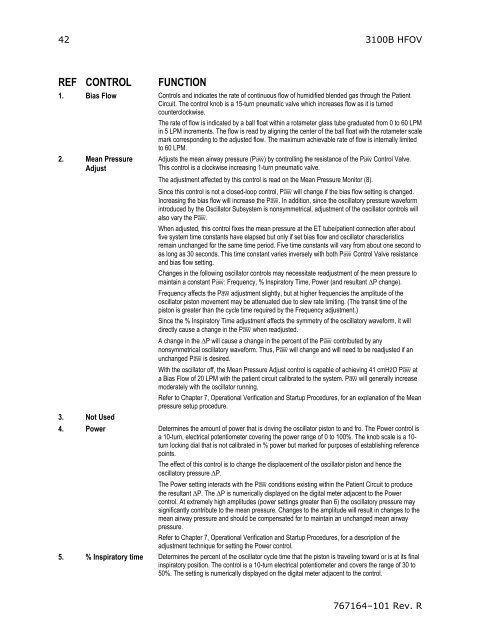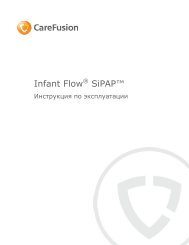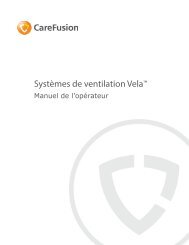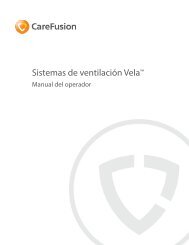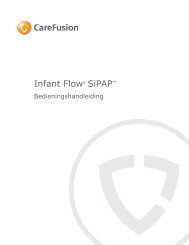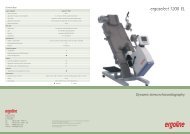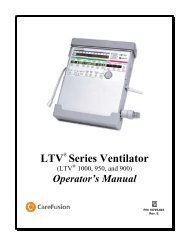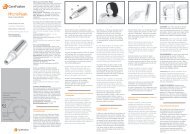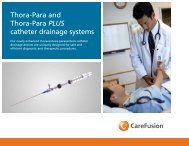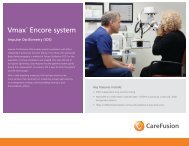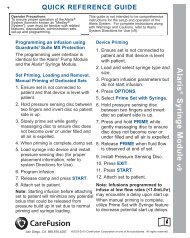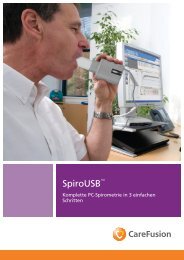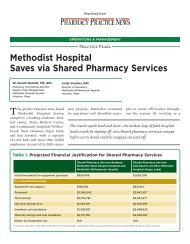3100B HFOV Operator Manual - CareFusion
3100B HFOV Operator Manual - CareFusion
3100B HFOV Operator Manual - CareFusion
Create successful ePaper yourself
Turn your PDF publications into a flip-book with our unique Google optimized e-Paper software.
42 <strong>3100B</strong> <strong>HFOV</strong><br />
REF CONTROL<br />
FUNCTION<br />
1. Bias Flow Controls and indicates the rate of continuous flow of humidified blended gas through the Patient<br />
Circuit. The control knob is a 15-turn pneumatic valve which increases flow as it is turned<br />
counterclockwise.<br />
The rate of flow is indicated by a ball float within a rotameter glass tube graduated from 0 to 60 LPM<br />
in 5 LPM increments. The flow is read by aligning the center of the ball float with the rotameter scale<br />
mark corresponding to the adjusted flow. The maximum achievable rate of flow is internally limited<br />
to 60 LPM.<br />
2. Mean Pressure<br />
Adjust<br />
Adjusts the mean airway pressure (Pa) by controlling the resistance of the Pa Control Valve.<br />
This control is a clockwise increasing 1-turn pneumatic valve.<br />
The adjustment affected by this control is read on the Mean Pressure Monitor (8).<br />
Since this control is not a closed-loop control, Pa will change if the bias flow setting is changed.<br />
Increasing the bias flow will increase the Pa. In addition, since the oscillatory pressure waveform<br />
introduced by the Oscillator Subsystem is nonsymmetrical, adjustment of the oscillator controls will<br />
also vary the Pa.<br />
When adjusted, this control fixes the mean pressure at the ET tube/patient connection after about<br />
five system time constants have elapsed but only if set bias flow and oscillator characteristics<br />
remain unchanged for the same time period. Five time constants will vary from about one second to<br />
as long as 30 seconds. This time constant varies inversely with both Pa Control Valve resistance<br />
and bias flow setting.<br />
Changes in the following oscillator controls may necessitate readjustment of the mean pressure to<br />
maintain a constant Pa: Frequency, % Inspiratory Time, Power (and resultant ∆P change).<br />
Frequency affects the Pa adjustment slightly, but at higher frequencies the amplitude of the<br />
oscillator piston movement may be attenuated due to slew rate limiting. (The transit time of the<br />
piston is greater than the cycle time required by the Frequency adjustment.)<br />
Since the % Inspiratory Time adjustment affects the symmetry of the oscillatory waveform, it will<br />
directly cause a change in the Pa when readjusted.<br />
A change in the ∆P will cause a change in the percent of the Pa contributed by any<br />
nonsymmetrical oscillatory waveform. Thus, Pa will change and will need to be readjusted if an<br />
unchanged Pa is desired.<br />
With the oscillator off, the Mean Pressure Adjust control is capable of achieving 41 cmH2O Pa at<br />
a Bias Flow of 20 LPM with the patient circuit calibrated to the system. Pa will generally increase<br />
moderately with the oscillator running.<br />
Refer to Chapter 7, Operational Verification and Startup Procedures, for an explanation of the Mean<br />
pressure setup procedure.<br />
3. Not Used<br />
4. Power Determines the amount of power that is driving the oscillator piston to and fro. The Power control is<br />
a 10-turn, electrical potentiometer covering the power range of 0 to 100%. The knob scale is a 10-<br />
turn locking dial that is not calibrated in % power but marked for purposes of establishing reference<br />
points.<br />
The effect of this control is to change the displacement of the oscillator piston and hence the<br />
oscillatory pressure ∆P.<br />
The Power setting interacts with the Pa conditions existing within the Patient Circuit to produce<br />
the resultant ∆P. The ∆P is numerically displayed on the digital meter adjacent to the Power<br />
control. At extremely high amplitudes (power settings greater than 6) the oscillatory pressure may<br />
significantly contribute to the mean pressure. Changes to the amplitude will result in changes to the<br />
mean airway pressure and should be compensated for to maintain an unchanged mean airway<br />
pressure.<br />
Refer to Chapter 7, Operational Verification and Startup Procedures, for a description of the<br />
adjustment technique for setting the Power control.<br />
5. % Inspiratory time Determines the percent of the oscillator cycle time that the piston is traveling toward or is at its final<br />
inspiratory position. The control is a 10-turn electrical potentiometer and covers the range of 30 to<br />
50%. The setting is numerically displayed on the digital meter adjacent to the control.<br />
767164–101 Rev. R


